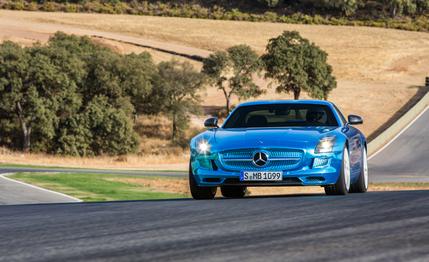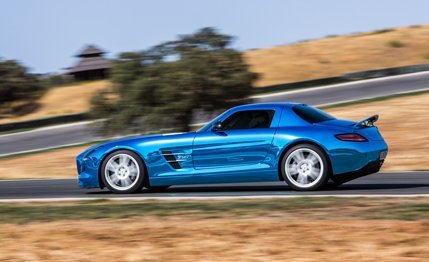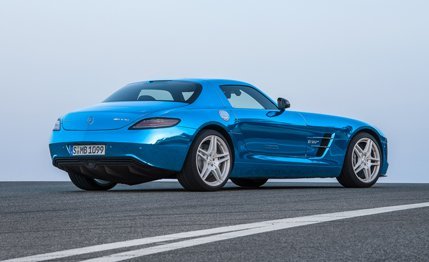
 First Drive Review
First Drive Review
The Mercedes-Benz SLS AMG electric drive boasts a 120-mile range and 738 horsepower, but don’t believe for a minute that you can enjoy both at the same time. When pushed to its full potential, the electric SLS won’t make it two laps around the 12.9-mile Nürburgring Nordschleife. This conundrum—manage the battery range or exercise the car’s muscle—makes the great power of the SLS ED sort of, well, a limp proposition.
But who are we kidding? Customers who can afford the $500,000-plus electric SLS will have people to worry about range anxiety for them. When deliveries begin later this year, the SLS ED will be a very quick, very fun novelty toy—batteries included—for fewer than 200 well-heeled Europeans. (There currently are no plans for U.S. sales.) For Mercedes-Benz and AMG, the electric gullwing is a research test bed exploring the future of electric propulsion and high-performance vehicles.
Quick to Discharge, Slow to Charge
The 60-kWh lithium-ion battery pack and the software that manages it were developed by the Formula 1 experts at Mercedes AMG High Performance Powertrains. The 1208-pound pack contains 864 South Korean battery cells encased in a carbon-fiber box that acts as a structural element when bolted to the SLS’s aluminum space frame. HPP’s experience with F1’s Kinetic Energy Recovery System was key to extracting big power from the battery, but the engineers didn’t make any strides when it comes to recharging the puck. Unless your garage is wired up like a public charging space, a full charge takes 20 hours—and that’s with 220 volts.


With four electric motors making 185 horsepower and 184 lb-ft of torque each, the total output of the electrified gullwing tops even that of the SLS AMG Black Series. Yet asking for all 738 lb-ft lacks the expected drama. The electric-drive model is undeniably quick off the line—we estimate 60 mph arrives in 3.7 seconds—but you won’t hear a chirp from the tires. That’s because torque is routed through fixed-ratio gearboxes that cover the entire speed spread, from creeping up to a stoplight to hitting the governor at 155 mph. To add some theater to the otherwise silent electric-car experience, AMG pipes a sci-fi soundtrack through the SLS’s 11 stereo speakers. “Idling” creates a whirring warble, like the sound of a UFO landing in a Warner Brothers cartoon, and there are similarly fantastical noises for startup, acceleration, cruising, and braking.
Because the four-wheel-drive electric SLS has driveshafts where the gas-powered car’s front springs and dampers reside, AMG engineers redesigned the front suspension. The control arms have been replaced by a multilink setup, and the coil-overs are mounted horizontally and actuated by pushrods. Other chassis changes include an electrically driven hydraulic steering pump (rather than a belt-driven unit) and standard carbon-ceramic brakes. Shift paddles behind the steering wheel adjust how aggressively the regenerative braking cuts in when you lift off the accelerator.
Hey, Everybody, Watch This!
The electric SLS’s primary party trick is a function of the four electric motors that power it. With each motor dedicated to driving a single wheel, the ED’s computers have precise control over the forces that make a car change direction. Accelerating and braking each motor independently of the others turns this 4700-pound brute into a ballerina. The level of torque vectoring—what AMG calls “torque dynamics”—can be set to one of three modes. In Comfort, the SLS electric drive can’t hide its 900-pound surplus over the gas model. The electric car is reluctant to change direction, and the steering is sluggish. With the body always a step behind the wheels, the SLS feels more like an S-class than a half-million-dollar sports car.


Switching to the most aggressive setting, Sport Plus, affects a transformation unlike that of any adaptive suspension or torque-vectoring differential we’ve ever experienced. Turn-in is defined by Lotus-like immediacy. The body moves perfectly in sync with the wheels and the driver’s intentions. The steering is prescient, and yet the four-corner torque control means you also influence your heading with the right pedal. If you underestimate a corner, simply squeeze on the throttle to tighten your line—not to induce oversteer but to increase the yaw moment. The outside wheels accelerate, the inside wheels slow, and the gullwing tucks in, darting for the inside. This four-wheel torque vectoring redefines the expression “steering with the throttle.” And although it’s unlike any car we’ve ever driven, this is the kind of electric car we can easily get behind.
Something to Look Forward To
The hyperexclusive, ultraexpensive SLS AMG electric drive is an anomaly in the world of battery-powered cars. It’s too radical to serve as basic transportation, and its range-limited battery keeps it from being a real track toy. Instead, its purpose is to serve as a development bench and proving ground for using smaller multiple motors rather than a single large motor. If the idea of dedicating a motor to an individual wheel becomes common practice, we’re looking forward to a future of hybrids and electrics.